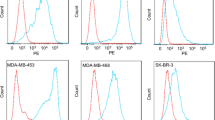Abstract
We have produced an adriamycin-conjugated monoclonal antibody, AMI, covalently linked by acid-labilecis-aconitic spacer. The immunoconjugate,cis- aconitic adriamycin (cAA)-AMl, was confirmed to retain the binding activity against human breast cancer cell lines by flow cytometry. The immunoconjugate was shown to be internalized into antigen-positive cancer cells by flow cytometry analysis and high performance liquid chromatography. Antitumor effects of cAA-AMl were assessed on human breast cancer and colon cancer cell lines, with inhibition of3H leucine uptakes to the cells. cAA-AM1 demonstrated a selective cytotoxicity to ZR-75- 1 which was reactive with AMI, whereas it showed no antitumor effect on SW1116 cells which did not react with AMI. Free adriamycin demonstrated a non-selective cytotoxicity against both cell lines. AMI alone and cAA-control IgM did not show any antitumor effect on ZR-75-1. These results suggest that cAA-AMl retains binding activity and specificity against breast cancer cellsin vitro.
Similar content being viewed by others
Abbreviations
- ADM:
-
Adriamycin
- cAA:
-
cis-Aconitic-adriamycin
- MAb:
-
Monoclonal antibody
- HPLC:
-
High performance liquid chromatography
- DMEM:
-
Dulbecco’s modified Eagle’s minimal essential medium
- FCS:
-
Fetal calf serum
- HEPES:
-
HydroxyethylpiperazineN’-2-ethansulfonic acid; EDC, N - Ethyl-N’- [(3-dimethyl-amino)propyl] carbodiimide hydrochloride
- MSR:
-
Molar substitution rario
- BSA:
-
Bovine serum albumin
- MFI:
-
Mean fluorescence intensity
References
Chabner BA, Myers CE: Clinical pharmacology of cancer chemotherapy. In: DeVita VT Jr, Hellman S, Rosenberg SA eds, Cancer; Principles and Practice of Oncology, 2nd ed, J. B. Lippincott Company, Philadelphia, pp287–328, 1985.
Casazza AM, Isetta AM, Giuliani F,et al: Immunodepressive activity of daunomycin and adriamycin. In: Staquet M, Tagnon H, Kenis Y,et al eds, Daunomycin and Adriamycin, European Press, Belgium, pp123–131, 1975.
Dillman RO: Monoclonal antibodies in the treatment of cancer.Crit Rev Oncol Hematol 1:357–386, 1984.
Oldman RK: Immunoconjugates; Drug Toxins, Raven Press, New York, pp319–336, 1987.
Dillman RO, Johnson DE, Shawler D,et al: Superiority of an acid-labile daunorubicin-monoclonal antibody immunoconjugate compared to free drug.Cancer Res 48:6097–6102, 1988.
Harada Y, Ohuchi N, Masuko T,et al: Breast cancer- associated antigen defined by monoclonal antibody generated against HMA-1 cell line.Tohoku J Exp Med 180:273–288, 1996.
Matano S, Ohuchi N, Hirakawa H,et al: Establishment of an estrogen receptor-positive cell line (HMA- 1) derived from human breast carcinoma.Tohoku J Exp Med 164:169–182, 1991.
Ohuchi N, Harada Y, Masuko T,et al: Characterization of cell surface antigens expressed in the HMA-1 breast cancer cell line.Surg Today 25:244–250, 1995.
Taeda Y, Nose M, Hiraizumi S,et al: Expression of LPHA-binding protein in breast cancer; Reconstitution and molecular characterization of 1-6 branched oligosaccharides in three-dimensional cell culture.Breast Cancer Res Treat 38:313–324, 1996.
Shen WC, Ryser HJP:cis-Aconityl spacer between daunomycin and macromolecular carrier; A model of pH - sensitive linkage releasing drug from a lysosomotropic conjugate.Biochem Biophys Res Commun 102:1048–1054, 1981.
Ballou B, Taylor RJ, Shen WC,et al: Daunomycin targeting to the MH-15 teratocarcinoma using anti-SSEA-1.Fed Proc 42:685, 1983.
Shen WC, Ballou B, Ryser HJP,et al: Targeting, internalization, and cytotoxicity of methotrexatemonoclonal anti-stage-specific embryonic antigen-1 antibody conjugates in cultured F-9 teratocarcinoma cells.Cancer Res 46:3912–3916, 1986.
Persiani S, Ballou B, Shen WC,et al: In vivo antitumor effect of methotrexate conjugated to a monoclonal IgM antibody specific for stage-specific embryonic antigen-1, on MH-15 mouse teratocarcinoma.Cancer Immunol Immunother 29:167–170, 1989.
Arnon R, Sela M:In vitro andin vivo efficacy of conjugates of daunomycin with antitumor antibodies.Immunol Rev 62:5–27, 1982.
Levy R, Hurwitz E, Marson R,et al: The specific cytotoxic effects of daunomycin conjugated to antitumor antibodies.Cancer Res 35:1182–1186, 1975.
Belles-Isles M, Page M:In vitro activity of daunomycin - anti - alphafetoprotein conjugate on mouse hepatoma cells.Br J Cancer 41:841–842, 1980.
Hurwitz E, Kashi R, Burowsky JD,et al: Site-directed chemotherapy with drug bound to anti-idiotypic antibody to a lymphoma cell-surface IgM.Int J Cancer 31:745–748, 1983.
DiMarco A: Adriamycin (NSC-123127); Mode and mechanism of action.Cancer Chemother Rep 6:91–106, 1975.
Hurwitz E, Maron R, Arnon R,et al: The covalent binding of daunomycin and adriamycin to antibodies, with retention of both drug and antibody activities.Cancer Res 35:1175–1181, 1975.
Yamamoto K, Acton EM, Henry PWA: Antitumor activity of some derivatives of daunomycin at the amino and methylketone functions.J Med Chem 15: 872–875, 1972.
Yang HM, Reisfeld RA: Doxorubicin conjugated with a monoclonal antibody directed to a human melanoma-associated proteoglycan suppresses the growth of established tumor xenografts in nude mice.Proc Natl Acad Sci USA 85:1189–1193, 1988.
Braslawsky G, Kandow K, McGoff K,et al: Adriamycin (hydrazone)-antibody conjugates require internalization and intracellular acidic hydrolysis for antitumor activity.Cancer Immunol Immunother 33: 367–374, 1991.
Author information
Authors and Affiliations
About this article
Cite this article
Ikegaki, H., Ohuchi, N., Masuko, T. et al. Characterization andin vitro cytotoxic effect of adriamycin conjugated monoclonal antibody prepared against breast cancer cell line. Breast Cancer 4, 85–92 (1997). https://doi.org/10.1007/BF02967061
Received:
Accepted:
Issue Date:
DOI: https://doi.org/10.1007/BF02967061




